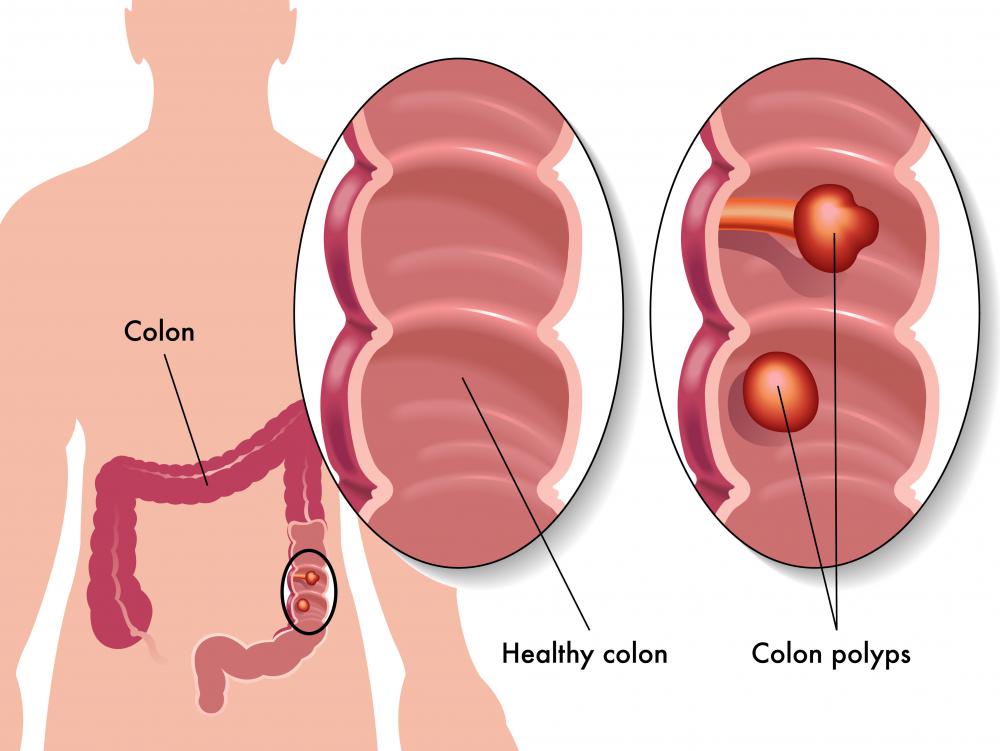At TheHealthBoard, we're committed to delivering accurate, trustworthy information. Our expert-authored content is rigorously fact-checked and sourced from credible authorities. Discover how we uphold the highest standards in providing you with reliable knowledge.
What Is a Sigmoid Polyp?
A sigmoid polyp is an abnormal collection of cells that grows in the sigmoid portion of the colon. This is the area of the colon that is closest to the rectum. In most cases, a sigmoid polyp is found to be non-cancerous, although the risk of cancer increases as the polyp grows larger. There are several different types of polyps that may be found in this area of the colon, including adenomatous polyps, hyperplastic polyps, and benign colon polyps. Surgical removal is the most common treatment method for this condition, especially if it causes symptoms such as bleeding or pain.
The most common type of sigmoid polyp is known as an adenomatous polyp. This type of polyp is usually non-cancerous, although the majority of colon polyps that are found to be cancerous are of this type. An adenomatous polyp may develop as a normal part of aging or due to dietary habits or genetics. As this type of growth has a relatively significant chance of becoming cancerous over time, most doctors will schedule surgery to remove it. If an adenomatous polyp is diagnosed and removed while it is still small, the risk of it being malignant, or cancerous, is a lot lower than if it has become a large growth.

Another possible type of polyp is known as a hyperplastic polyp. This type of growth is usually quite small and has virtually no chance of becoming cancerous. At the same time, it is sometimes difficult for a doctor to distinguish between a hyperplastic and an adenomatous polyp without performing a biopsy. For this reason, surgery is generally performed to remove the polyp itself, or a small portion of the polyp may be removed for further testing. Many doctors prefer to remove the entire polyp instead of risking the chance that the patient may later require an additional surgical procedure to remove the polyp, depending on biopsy results.

A benign colon polyp is yet another potential type of sigmoid polyp. This type of non-cancerous growth may be caused by inflammatory bowels diseases such as ulcerative colitis or Crohn's disease. Fortunately, this type of sigmoid polyp does not tend to cause any additional health concerns. If the growth is found to be cancerous, which is relatively uncommon, the medical staff will advise the patient on the best course of treatment for the individual situation. Treatment options may include surgery, chemotherapy, or radiation treatments.
AS FEATURED ON:
AS FEATURED ON:
















Discussion Comments
I am getting ready to have a surgeon remove a single polyp over 20mm in size and about 20 cm from the entry site.
Since I am an older woman with a weight problem (260 pounds, 5'5") she has put me on a protein and veggie diet. Is this normal? She is proposing to remove the entire section of the sigmoid colon where the polyp is located. I am scared. She has said it would be a three to four hour surgery and that it can't be put off for fear it will turn cancerous. My maternal grandfather died of colon cancer. The death certificate listed Polyps
1. Carcinoma of Colon with
2. Generalized Metastasis
He was 74 I am now 66. I can remember my mom saying he went in every year to have the polyps removed. And six months after the last removal, he was diagnosed with colon cancer. Can you offer any help?
I had a scope done six years ago and had only one. This time I had six removed with the seventh requiring surgery.
I just had a colonoscopy a few days ago. The doctor removed six diminutive polyps, four 3 to 5 mm polyps and four 6 to 9 mm polyps, all in the sigmoid colon. I'm waiting for a pathology report. I'm sitting on pins and needles waiting for the report. The four 6 to 9mm polyps to me seem very large. Altogether, 15 polyps seem like overkill, or is this about normal?
My last colonoscoopy was 10 years ago, and I had only one polyp. Ten years later, I have 15 polyps. Does size of a polyp determine that the chance of cancer can be greater?
I have no family history of colon cancer and was completely surprised when I had a colonoscopy done and they found precancerous polyps.
I was at my doctor's for my annual exam and was over the recommended age of having this done, so he scheduled it for me.
Since I wasn't having any problems, I assumed everything would come back normal. It is pretty scary when they tell you they found something that could lead to cancer.
I had these polyps removed by surgery, but it was also a wake up call for me. I was overweight and was not very good about eating healthy foods. Since then I have lost some weight, began exercising on a regular basis, and have made a lot of changes in my diet.
@LisaLou - Yes, when they find out there is colon cancer in your family, they really watch you closely.
Both of my parents died of colon cancer, so I really have to watch out for this. The first procedure I had done was a sigmoidoscopy. This is similar to a colonoscopy, but I don't think it is as thorough.
The second time this was scheduled, I had a colonoscopy and polyps were found. Because of my family history, and they found polyps, I have to have this repeated every 2-3 years.
I have four siblings and we are all close in age. Two of my siblings haven't had anything checked out yet and I keep encouraging them to get it done as soon as possible.
There is a lot that can be done if this is found early and you concentrate on eating a healthy diet with a lot of fiber.
@honeybees - I have a family history of colon cancer too. Because of this, I was encouraged to get a colonoscopy 10 years before the average person.
This is often hereditary, so they figure if they can take preventative measures, you have a good chance of catching it early if you are going to have problems.
They told me if they found any precancerous polyps, they would go ahead and remove them. Fortunately they didn't find any so that was a relief.
I am supposed to stay on a 5 year schedule to be checked for this. My 5 years is coming up soon, and even though I dread having it done, I know how important it is.
When my dad was in his 50's he was diagnosed with colon cancer. He had surgery for this and is now in his 80's and doing very well.
I don't know how many colonoscopy procedures he has had since then, but there have been a lot of them. I don't know how he does it, but he stays awake and watches them when they do this.
Many times since his cancer, they have found some polyps in his colon. Because of his history, they always remove these polyps and send them in for a biopsy to make sure they are not cancerous.
So far, they have all been negative. He is so thankful they found the cancer early and he has not had any problems with it spreading or coming back.
Post your comments